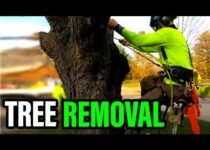Homeowners Guide to Tree Removal
If a tree has become dead or diseased, is obstructing views, blocking light to your yard or driveway, or is overgrown with roots into utility lines or structures, it may be time for removal. A tree removal process involves cutting down the entire tree, chopping up branches or sections into smaller pieces for transport or to keep on your property for firewood, and clearing the area around the fallen trunk. The process is complicated, so it’s best left to professional arborists with experience and equipment like cranes. However, there are a few steps homeowners can take to make the process go more smoothly and ensure safety during and after the tree is removed.
Assessing the tree’s height is a necessary first step before any work can begin. There needs to be enough room around the base of the tree for it to fall flat and not hit a structure or person. An arborist will measure the distances to buildings, fences, parked cars, sprinkler heads, septic tanks, oil tank fields, or other structures, and will determine whether there is sufficient space to safely fell the tree.
A second important assessment is which way the tree naturally leans. This will determine the direction the tree will fall, which can affect injury to people and damage to property if cut in the wrong place. An arborist will circle the tree and look at it from all sides to ensure they have an accurate sense of which way it leans.
When it comes to removing a large, mature tree, you will likely need to have a permit. This is especially true if the tree is near a house or other structures that can be damaged by a falling branch or trunk. Many cities have ordinances that require homeowners to obtain a permit to remove trees over a certain size, or even smaller ones if they’re obstructing a sidewalk or roadway.
Getting a permit can be time consuming and expensive, but not having one can result in fines and other legal action if the tree falls or hits something you own. If you don’t feel comfortable getting a permit, you can hire an arborist to do it for you.
Once a permit is secured, the next step is to prep the area. This includes clearing out vehicles, lawn furniture, and other items that could be swept away by the tree. You should also clear out any tripping hazards or other obstructions, as well as brush that could be tangled in the trunk when it falls. Clearing at least two escape routes on the opposite side of the tree will be helpful, too.
When it comes to preparing for the actual tree removal, watering the ground the day before will help it be easier to dig. Have all of your equipment ready, including chainsaws, leg braces, safety glasses or goggles, and a long, sharp blade. It’s also a good idea to have wedges on hand in case the tree proves difficult to bring down.


